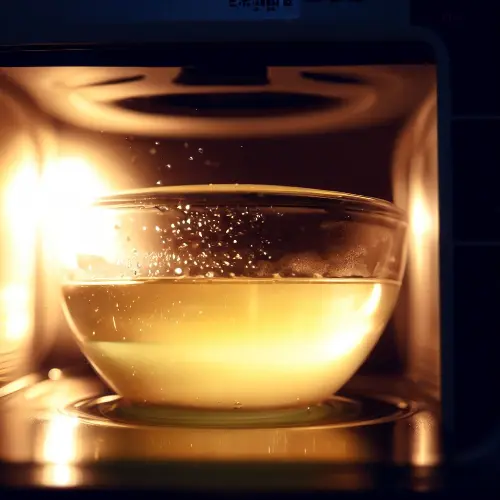Table of Contents
Can You Melt Coconut Oil In The Microwave
Yes, you can melt coconut oil in the microwave. Coconut oil has become incredibly popular in recent years. From cooking to skincare, coconut oil is an extremely versatile product. But what’s the best way to melt coconut oil to get it into a liquid state for use? Can you use the microwave to melt coconut oil? Let’s take a closer look.
What is Coconut Oil?
Coconut oil is an edible oil that comes from the meat of mature coconuts. It contains a high amount of saturated fats, making it solid at room temperature. Coconut oil is available in refined and unrefined varieties. Unrefined or virgin coconut oil is usually preferred, as it retains more of the coconut flavor and has higher levels of antioxidants.
Coconut oil has many uses. It can be used for cooking, especially for high-heat cooking methods like sautéing and frying. The high smoke point of 350°F makes it suitable for these cooking techniques. It can also be used for baking. Coconut oil is very moisturizing and often used in homemade beauty products like body scrubs and lotions.
Melting Coconut Oil in the Microwave?
Yes, you can absolutely melt coconut oil in the microwave. The microwave provides a quick and convenient way to liquefy solid coconut oil. Microwaving coconut oil takes just a minute or two, much faster than other methods.
It’s important to use care when microwaving coconut oil to avoid splattering or overheating the oil. But with the right technique, the microwave can be very effective.
Instructions for Melting Coconut Oil in the Microwave
Follow these instructions to safely melt coconut oil in the microwave:
- Use a microwave-safe container. Glass jars or bowls work best. Make sure it’s big enough to avoid overflow as the coconut oil melts.
- Add the desired amount of coconut oil. Measure out the amount of solid coconut oil you need melted.
- Microwave in short 10-second intervals. Heat the coconut oil for only 10 seconds at a time. Then stir and continue microwaving in 10-second bursts, stirring in between, until melted.
- Stop microwaving before completely melting. Coconut oil holds heat very well and will continue melting off heat. Stop just before fully melts to avoid overheating.
- Stir well and let sit 1-2 minutes. Give the coconut oil a final stir after microwaving, then let it sit to finish melting.
- Use care when removing it from the microwave. The oil will be hot! Use oven mitts and remove them slowly to avoid spills.
- Store any leftover oil in a cool place to re-solidify. Coconut oil can be reused multiple times.
Tips for Microwaving Coconut Oil
Here are some useful tips to get the best results when microwaving coconut oil:
- Use lower microwave power, around 50%. This helps melt the oil more gently.
- Start with a cold jar. If the coconut oil is already warm or melted, it can splatter in the microwave.
- Submerge the jar in a bowl of water. This creates more even heating and reduces the risk of superheating the oil.
- Stir frequently. Stirring prevents hot spots that can lead to splattering or burning.
- Use a microwave cover. A paper towel or plastic microwave cover can minimize messes.
- Watch it closely! Don’t walk away, so you can stop the microwave as soon as the oil is nearly melted.
- Add other ingredients after. Mix in other foods after melting the coconut oil to avoid uneven heating.
Why Melting Coconut Oil in the Microwave Works
Melting coconut oil in the microwave is effective for a few key reasons:
- Fast and direct heat – Microwaves work by creating heat through the vibration of water molecules. The fast, direct heat quickly melts the solid coconut oil.
- Heat retention – Coconut oil has a high heat retention compared to other oils. It holds heat well to stay liquid after microwaving.
- Small quantities – A microwave can easily handle the small amounts of coconut oil needed for most recipes and uses.
- Convenience – No stovetop or double boiler is needed. Just pop it in the microwave for fast results.
Other Ways to Melt Coconut Oil
While the microwave provides a fast option, there are other methods to liquefy coconut oil as well:
- Stovetop: Heat coconut oil in a small saucepan or pot over very low heat. Stir frequently.
- Water bath: Place a bowl with coconut oil over a pot of simmering water to melt gently.
- Slow cooker: Add coconut oil to a slow cooker on a warm or low setting to melt over time.
- Double boiler: Use a double boiler with a bowl over simmering water to melt the oil gradually.
- Leave at room temperature: Coconut oil will slowly liquefy at normal room temperature of around 70°F.
No matter which method you prefer, avoid overheating coconut oil to preserve its quality. With the right techniques, it can easily be melted and used in its convenient liquid form!
FAQs
Is it safe to microwave coconut oil?
Yes, as long as proper precautions are taken, microwaving coconut oil is generally safe. Use a microwave-safe container, microwave at lower power in short intervals, stirring frequently, and don’t overheat the oil. This prevents any dangers of splattering or burning.
Can coconut oil catch fire in the microwave?
It’s extremely unlikely, but technically possible if severely overheated. This is why it’s crucial not to microwave coconut oil unattended and avoid prolonged heating at high power. As long as you melt the oil gently and in short bursts, fire should never be a concern.
Does microwaving destroy the nutrients in coconut oil?
No. Brief exposure to microwave heating does not significantly damage the fatty acids, vitamins or other nutrients in coconut oil. To preserve nutrition, just avoid prolonged heating or letting the oil smoke.
Why does coconut oil get lumpy in the microwave?
You may notice some small lumps as coconut oil melts in the microwave. This is caused by the solid pieces of oil heating and melting at different rates. Stirring frequently should help smooth out any lumps for evenly melted oil.
Can you use a microwave to harden coconut oil?
Yes, a microwave can help hasten the solidifying process if needed. Just microwave the liquid oil in short bursts until it starts looking opaque and semi-solid. Then let it finish hardening at room temperature.
Is virgin or refined coconut oil better for microwaving?
Both work well, but virgin coconut oil has a more pronounced coconut flavor that some prefer. Refined oil has a higher smoke point (400°F vs. 350°F) but both are safe for the short microwave times.
Conclusion
Melting solid coconut oil in the microwave is a fast, safe, and effective technique. With some care to avoid overheating, the microwave provides a convenient way to liquefy coconut oil for cooking, baking, or other uses in just a minute or two. Give it a try the next time a recipe calls for melted coconut oil!

I’m Ian Welkins, a seasoned professional in the kitchen industry. My passion now drives me to provide invaluable insights into the world of top-notch kitchen products. With years of hands-on experience, I’m your go-to source for culinary excellence.











